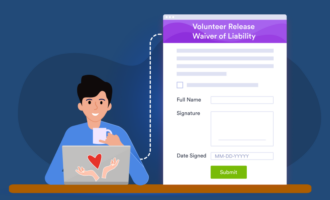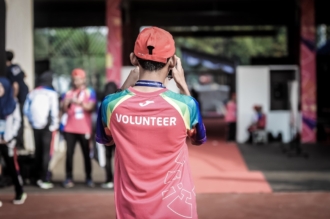Improving your volunteer onboarding process
- Use software
- Ask for feedback
- Provide training
- Digitize your onboarding paperwork
- Create a welcoming environment
Nonprofits do a lot for our communities. They provide jobs, support local businesses, and strive to create a positive impact on society.
Unfortunately, due to limited funds and resources, nonprofits often struggle to accomplish their goals with limited means. As charitable giving declines, it’s more important than ever for nonprofits to communicate the impact of their donations to donors. Donors need to see the work organizations are doing and know how those organizations are using their money.
The problem? Nonprofits have exceedingly high turnover rates, and they rely heavily on unpaid volunteers to pick up some of the slack, meaning it can be difficult to accomplish their missions. Nonprofits are also faced with the challenge of finding and retaining reliable, high-quality volunteers.
So, to help retain your new volunteers to support your nonprofit’s goals, it’s smart to have a smooth, organized volunteer onboarding process.
Discover how a nonprofit museum streamlined their volunteer management. Learn from their experience to optimize your own onboarding efforts with nonprofit forms.
The volunteer onboarding process: What it is
Volunteer onboarding gives your volunteers a chance to learn more about your nonprofit — like through an in-office tour and a presentation with key executives, for example — and how their role fits within the organization. It provides them the opportunity to
- Receive and submit onboarding paperwork
- Ask questions about their role or assigned project
- Build on their existing skills and develop new ones
- Learn more about your organization’s culture, structure, expectations, and mission
- Meet new people
Benefits of volunteer onboarding
Most importantly, a successful volunteer onboarding process increases the likelihood that they’ll return to your organization in the future. The more comfortable your volunteers feel in their roles, with each other and with their managers, the more confident — and driven — they’ll be to continue signing up to support your cause.
And while each nonprofit’s volunteer onboarding process looks a bit different based on size, funding, and mission, the basic elements are similar.
Your ultimate goal is to get your new volunteer familiar with the people and processes that make your organization work, so they can contribute in a meaningful way from their first day volunteering with you.
Answering their questions up front and showing them around your workspace will help volunteers
- Understand your organization’s mission and vision
- Minimize confusion about their role and responsibilities
- Empower them to make confident decisions
- Adhere to relevant policies and procedures
Volunteer onboarding steps
Here’s a step-by-step guide to welcoming new volunteers.
1. Gather background information
When working with a new volunteer, it’s helpful to know their strengths, weaknesses, and former experiences, so you can determine how they can best meet your organization’s needs. Some volunteers may be seasoned in the area they’ll be working in, while others may be venturing into their assignment for the first time.
Whether you sit down and speak with your volunteer or have them submit a form, making an intentional effort to understand where they’re coming from means you can get newer volunteers up to speed, and you won’t waste time teaching a skilled volunteer things they already know.
2. Orientation and training
Orientation sets your volunteers up for success as they begin their work. Each organization will have different needs and therefore different things to train volunteers on, but in general, this is the time to explain the volunteer’s duties. Orientation and training can be remote or in person, as well as individual or in a group setting.
By the end of orientation and training, volunteers should know when and where to report, where to find necessary materials, and what they should aim to accomplish during their shift.
3. Evaluation
After a volunteer gets at least one shift under their belt, evaluate their performance. While you can observe their work directly, you should also ask them what they feel went well and what could have gone better. Asking these questions gives you a chance to clear up any misunderstandings and provide guidance on how they can better meet expectations.
5 ways to improve your volunteer onboarding process
To enhance your volunteer onboarding process, there are a few simple tips and tricks you can implement. Here are five suggestions.
1. Use software
One of the most effective ways to improve your volunteer onboarding system (as well as everyday operations) is by implementing some type of software solution. Software — like online form builder Jotform, for example — helps you more efficiently schedule and screen volunteers, handle event registration, streamline your internal workflows, and simplify your approval process, ensuring both staff and volunteers are on the same page. Jotform is customizable, intuitive, code-free, and even offers nonprofits a 50 percent discount.
Best of all, it can help with everything else on this list, thanks to its built-in library of premade form templates that are easy to customize for your needs.
2. Ask for feedback
If you don’t know what’s working and what’s not within your existing volunteer onboarding process, how can you improve it? Fortunately, there’s an easy way to measure your existing onboarding program: by sending, collecting, and analyzing a feedback survey.
In your survey, ask respondents what they like and dislike about the onboarding process, what they wish there was more or less of, and what suggestions they have on how to make tangible adjustments. For best results, send surveys to both your employees and trainers and your current and prior volunteers. This will help cover your bases and provide more accurate, actionable feedback.
3. Provide training
Though new volunteers can train with current staff or learn on the go, creating a more formal training process can greatly improve the overall onboarding experience. It defines expectations, ensures consistency, documents progress, and prioritizes communication and collaboration between managers, staff, and volunteers.
Once you have a better idea of all that’s involved with your specific training program — like the labor and resources required — you’ll know more about what you should have on site, how many trainers you need, and how long it will take to complete (which your staff and volunteers alike will appreciate).
4. Digitize your onboarding paperwork
Use technology to your advantage by sending all volunteer forms — from registration to background checks — to your volunteers prior to their orientation date. Not only does this digitize all important information in one central location, but it also ensures that the onboarding process is dedicated to more useful, productive activities, like training, networking, and asking questions.
In addition to digitizing volunteer paperwork, be sure to put all important volunteer information online for easy access, including role responsibilities, start date, arrival time, and relevant marketing materials.
5. Create a welcoming environment
Let’s face it — volunteering somewhere new can be scary. New volunteers don’t know anyone, are likely afraid to ask too many questions, and don’t want to make any mistakes. So, as you’re auditing your current volunteer onboarding process, create a welcoming space that makes them feel safe, confident, and motivated — whether your orientation is online or in person.
To accomplish this, consider
- Providing a catered breakfast or lunch
- Starting off with a few ice breaker games or questions
- Spreading out breaks throughout the day so they can use the restroom, make a call, or simply digest all the information they’ve received
- Printing or emailing all the material you’ve covered in the orientation so they can reference it later
Volunteer onboarding checklist
Welcoming a new volunteer to your organization doesn’t have to be a stressful process. Volunteers bring a wealth of benefits to organizations. The more efficiently you complete their onboarding, the quicker they can make an impact. Here’s a checklist you can refer to as you go through the onboarding process:
- Distribute, collect, and review onboarding paperwork.
- Learn about your volunteer’s background through an interview or survey.
- Provide orientation and training, answer any questions, and show your volunteer around the facilities.
- Welcome the volunteer to their first shift.
- Evaluate their performance.
Volunteers help organizations complete important tasks and projects efficiently on a limited budget. They’re invaluable to nonprofits and should be made to feel that way the moment they sign up with your organization. Thankfully, with an organized, clear, and efficient volunteer onboarding process in place, they will, especially if you implement these tips.
Photo by Joel Muniz on Unsplash
















Send Comment: